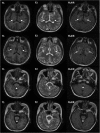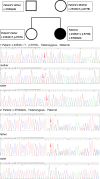Wilson's disease combined with systemic lupus erythematosus: a case report and literature review
- PMID: 29907136
- PMCID: PMC6002982
- DOI: 10.1186/s12883-018-1085-5
Wilson's disease combined with systemic lupus erythematosus: a case report and literature review
Abstract
Background: Wilson's disease (WD) is an inherited disorder in which defective biliary excretion of copper leads to its accumulation, particularly in the liver and brain. Systemic lupus erythematosus (SLE) is a multi-system disorder that can manifest in any system. Cases with concomitant WD and SLE, unrelated to treatment with penicillamine, have been rarely reported.
Case presentation: We report a case of a young woman who had typical neuropsychiatric symptoms and laboratory tests results of WD. She also had concomitant massive hematuria and proteinuria, fever, multiple positive autoimmune antibodies, hypocomplementemia, abnormal lumbar puncture findings and evidence of Sjögren syndrome, which are all rare in WD. Hence, we considered the diagnosis of SLE. Tapering of steroid dosage also confirmed the diagnosis.
Conclusion: Wilson's disease and SLE have varied clinical manifestations. Herein, we reported a rare case in which the two conditions concomitantly existed. In clinical practice, differential diagnosis of the two diseases is necessary for patients with hepatic, neurological, and psychiatric manifestations.
Keywords: Systemic lupus erythematosus; Wilson’s disease.
Conflict of interest statement
Ethics approval and consent to participate
This case report was approved by the Ethics Board of Peking Union Medical College Hospital.
Consent for publication
Written informed consent was obtained from the patient and her parents for publication of this case report and any accompanying images. A copy of the written consent is available for review by the Editor of this journal.
Competing interests
The authors declare that they have no competing interests.
Publisher’s Note
Springer Nature remains neutral with regard to jurisdictional claims in published maps and institutional affiliations.
Figures
Similar articles
-
Co-occurring Wilson's disease and non-penicillamine-induced systematic lupus erythematosus: a case report and literature review.Clin Rheumatol. 2021 Jun;40(6):2485-2490. doi: 10.1007/s10067-020-05463-z. Epub 2020 Oct 15. Clin Rheumatol. 2021. PMID: 33057918 Review.
-
Systemic lupus erythematosus combined with Wilson's disease: a case report and literature review.BMC Pediatr. 2024 Apr 15;24(1):253. doi: 10.1186/s12887-024-04713-2. BMC Pediatr. 2024. PMID: 38622515 Free PMC article. Review.
-
Wilson's disease treated with penicillamine and lupus erythematosus: related or distinct entities?Minerva Pediatr. 2012 Feb;64(1):55-7. Minerva Pediatr. 2012. PMID: 22350045
-
Co-occurrence of Wilson's disease and systemic lupus erythematosus: a case report and literature review.BMC Gastroenterol. 2021 May 21;21(1):229. doi: 10.1186/s12876-021-01814-5. BMC Gastroenterol. 2021. PMID: 34020599 Free PMC article. Review.
-
[A case of fulminant hepatic failure in Wilson's disease combined with systemic lupus erythematosus].Taehan Kan Hakhoe Chi. 2002 Mar;8(1):100-4. Taehan Kan Hakhoe Chi. 2002. PMID: 12499822 Korean.
Cited by
-
Unmasking the Duo: Wilson's Disease in the Context of Lupus and Existing Hepatitis E Coinfection.Clin Case Rep. 2025 Mar 27;13(4):e70368. doi: 10.1002/ccr3.70368. eCollection 2025 Apr. Clin Case Rep. 2025. PMID: 40161035 Free PMC article.
-
Co-occurring Wilson's disease and non-penicillamine-induced systematic lupus erythematosus: a case report and literature review.Clin Rheumatol. 2021 Jun;40(6):2485-2490. doi: 10.1007/s10067-020-05463-z. Epub 2020 Oct 15. Clin Rheumatol. 2021. PMID: 33057918 Review.
-
Genetically Confirmed Wilson Disease: A Retrospective Cohort Study From Bahrain.Cureus. 2024 Oct 18;16(10):e71805. doi: 10.7759/cureus.71805. eCollection 2024 Oct. Cureus. 2024. PMID: 39559689 Free PMC article.
-
The Spectrum of Movement Disorders Associated with Systemic Lupus Erythematosus.Curr Neurol Neurosci Rep. 2024 Nov 22;25(1):4. doi: 10.1007/s11910-024-01397-0. Curr Neurol Neurosci Rep. 2024. PMID: 39576409 Review.
-
When Copper Meets Autoimmunity: A Rare Coexistence of Wilson's Disease and Systemic Lupus Erythematosus.Clin Case Rep. 2025 Feb 19;13(2):e70159. doi: 10.1002/ccr3.70159. eCollection 2025 Feb. Clin Case Rep. 2025. PMID: 39980896 Free PMC article.
References
-
- Guha SK, Modak D, Basu A, et al. Coomb’s positive autoimmune Haemolytic Anaemia in a case of Wilson disease: co-incidence or association? JIACM. 2009;10(1 & 2):78–80.
Publication types
MeSH terms
Grants and funding
LinkOut - more resources
Full Text Sources
Other Literature Sources
Medical



